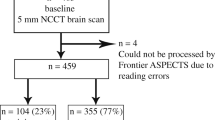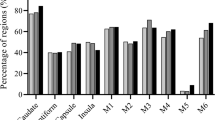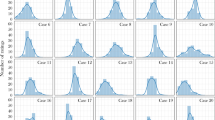Abstract
Objectives
The Alberta Stroke Program Early CT Score (ASPECTS) is a semi-quantitative method to evaluate the severity of early ischemic change on non-contrast computed tomography (NCCT) in patients with acute ischemic stroke (AIS). In this work, we propose an automated ASPECTS method based on large cohort of data and machine learning.
Methods
For this study, we collected 3626 NCCT cases from multiple centers and annotated directly on this dataset by neurologists. Based on image analysis and machine learning methods, we constructed a two-stage machine learning model. The validity and reliability of this automated ASPECTS method were tested on an independent external validation set of 300 cases. Statistical analyses on the total ASPECTS, dichotomized ASPECTS, and region-level ASPECTS were presented.
Results
On an independent external validation set of 300 cases, for the total ASPECTS results, the intraclass correlation coefficient between automated ASPECTS and expert-rated was 0.842. The agreement between ASPECTS threshold of ≥ 6 versus < 6 using a dichotomized method was moderate (κ = 0.438, 0.391–0.477), and the detection rate (sensitivity) was 86.5% for patients with ASPECTS threshold of ≥ 6. Compared with the results of previous studies, our method achieved a slight lead in sensitivity (67.8%) and AUC (0.845), with comparable accuracy (78.9%) and specificity (81.2%).
Conclusion
The proposed automated ASPECTS method driven by a large cohort of NCCT images performed equally well compared with expert-rated ASPECTS. This work further demonstrates the validity and reliability of automated ASPECTS evaluation method.
Clinical relevance statement
The automated ASPECTS method proposed by this study may help AIS patients to receive rapid intervention, but should not be used as a stand-alone diagnostic basis.
Key Points
-
NCCT-based manual ASPECTS scores were poorly consistent.
-
Machine learning can automate the ASPECTS scoring process.
-
Machine learning model design based on large cohort data can effectively improve the consistency of ASPECTS scores.






Similar content being viewed by others
Abbreviations
- AIS:
-
Acute ischemic stroke
- ASPECTS:
-
Alberta Stroke Program Early CT Score
- C:
-
Caudate head
- GLCM:
-
Gray-level co-occurrence matrix
- GLDM:
-
Gray-level dependence matrix
- GLRLM:
-
Gray-level run length matrix
- GLSZM:
-
Gray-level size zone matrix
- I:
-
Insula
- IC:
-
Internal capsule
- ICC:
-
Intraclass correlation coefficient
- IQR:
-
Interquartile range
- L:
-
Lentiform nucleus
- LBP:
-
Local binary pattern
- LVO:
-
Large vessel occlusion
- M1:
-
Frontal operculum
- M2:
-
Temporal lobe
- M3:
-
Posterior temporal lobe
- M4:
-
Anterior MCA
- M5:
-
Lateral MCA
- M6:
-
Posterior MCA
- MCA:
-
Middle cerebral artery
- NCCT:
-
Non-contrast computed tomography
- NGTDM:
-
Neighboring gray-tone difference matrix
- SOTA:
-
State-of-the-art
References
Van der Worp HB, Van Gijn J (2007) Acute ischemic stroke. N Engl J Med 357(6):572–579
Xing L, Jing L, Tian Y et al (2020) High prevalence of stroke and uncontrolled associated risk factors are major public health challenges in rural northeast China: a population-based study. Int J Stroke 15(4):399–411
Demeestere J, Scheldeman L, Cornelissen SA et al (2018) Alberta stroke program early CT score versus computed tomographic perfusion to predict functional outcome after successful reperfusion in acute ischemic stroke. Stroke 49(10):2361–2367
Barber PA, Demchuk AM, Zhang J, Buchan AM (2000) Validity and reliability of a quantitative computed tomography score in predicting outcome of hyperacute stroke before thrombolytic therapy. Lancet 355(9216):1670–1674
Kim JG, Lee D, Choi JC, Song Y, Lee DH, Suh DC (2019) DWI-pc-ASPECT score in basilar artery occlusion: is 6 points or less always indicative of a bad outcome? Interv Neuroradiol 25(4):371–379
Finlayson O, John V, Yeung R et al (2013) Interobserver agreement of ASPECT score distribution for noncontrast CT, CT angiography, and CT perfusion in acute stroke. Stroke 44(1):234–236
Kuang H, Najm M, Chakraborty D et al (2019) Automated ASPECTS on noncontrast CT scans in patients with acute ischemic stroke using machine learning. AJNR Am J Neuroradiol 40(1):33–38
Maegerlein C, Fischer J, Mönch S et al (2019) Automated calculation of the Alberta Stroke Program Early CT Score: feasibility and reliability. Radiology 291(1):141–148
Sundaram VK, Goldstein J, Wheelwright D et al (2019) Automated ASPECTS in acute ischemic stroke: a comparative analysis with CT perfusion. AJNR Am J Neuroradiol 40(12):2033–2038
Cao Z, Xu J, Song B et al (2022) Deep learning derived automated ASPECTS on non-contrast CT scans of acute ischemic stroke patients. Hum Brain Mapp 43(10):3023–3036
Guberina N, Dietrich U, Radbruch A et al (2018) Detection of early infarction signs with machine learning-based diagnosis by means of the Alberta Stroke Program Early CT Score (ASPECTS) in the clinical routine. Neuroradiology 60:889–901
Nagel S, Sinha D, Day D et al (2017) e-ASPECTS software is non-inferior to neuroradiologists in applying the ASPECT score to computed tomography scans of acute ischemic stroke patients. Int J Stroke 12(6):615–622
Li L, Chen Y, Bao Y et al (2020) Comparison of the performance between Frontier ASPECTS software and different levels of radiologists on assessing CT examinations of acute ischemic stroke patients. Clin Radiol 75(5):358–365
Qiu W, Kuang H, Teleg E et al (2020) Machine learning for detecting early infarction in acute stroke with non–contrast-enhanced CT. Radiology 294(3):638–644
Herweh C, Ringleb PA, Rauch G et al (2016) Performance of e-ASPECTS software in comparison to that of stroke physicians on assessing CT scans of acute ischemic stroke patients. Int J Stroke 11(4):438–445
Brinjikji W, Abbasi M, Arnold C et al (2021) e-ASPECTS software improves interobserver agreement and accuracy of interpretation of aspects score. Interv Neuroradiol 27(6):781–787
Adamou A, Beltsios ET, Bania A et al (2022) Artificial intelligence-driven ASPECTS for the detection of early stroke changes in non-contrast CT: a systematic review and meta-analysis. J Neurointerv Surg 0:1–7
Hoopes A, Mora JS, Dalca AV, Fischl B, Hoffmann M (2022) SynthStrip: skull-stripping for any brain image. Neuroimage 260:119474
Dong X, Yu Z, Cao W, Shi Y, Ma Q (2020) A survey on ensemble learning. Front Comput Sci 14:241–258
Chen T, Guestrin C (2016) XGBoost: a scalable tree boosting system. In Proceedings of the 22nd ACM SIGKDD international conference on knowledge discovery and data mining 2016: 785-794
Wolff L, Berkhemer OA, Van Es AC et al (2021) Validation of automated Alberta Stroke Program Early CT Score (ASPECTS) software for detection of early ischemic changes on non-contrast brain CT scans. Neuroradiology 63:491–498
Chen W, Wu J, Wei R et al (2022) Improving the diagnosis of acute ischemic stroke on non-contrast CT using deep learning: a multicenter study. Insights Imaging 13(1):1–12
Hoelter P, Muehlen I, Goelitz P, Beuscher V, Schwab S, Doerfler A (2020) Automated ASPECT scoring in acute ischemic stroke: comparison of three software tools. Neuroradiology 62:1231–1238
Delio PR, Wong ML, Tsai JP et al (2021) Assistance from automated ASPECTS software improves reader performance. J Stroke Cerebrovasc Dis 30(7):105829
Albers GW, Wald MJ, Mlynash M et al (2019) Automated calculation of Alberta Stroke Program Early CT Score: validation in patients with large hemispheric infarct. Stroke 50(11):3277–3279
Kuang H, Menon BK, Sohn SI, Qiu W (2021) EIS-Net: segmenting early infarct and scoring ASPECTS simultaneously on non-contrast CT of patients with acute ischemic stroke. Med Image Anal 70:101984
Aljabar P, Heckemann RA, Hammers A, Hajnal JV, Rueckert D (2009) Multi-atlas based segmentation of brain images: atlas selection and its effect on accuracy. Neuroimage 46(3):726–738
Acknowledgements
We would like to acknowledge the contribution of neurologists Dr. Shu Wan and Dr. Sheng Guan for their valuable assistance with the clinical interpretation. We also would like to thank the following colleagues: Wei Lu, Yu Fu, Ming Wang, Kaizheng Liu, Sijing Chen, Wubiao Chen, Yang Wang, Jun Wu, Xiaochang Leng, Jens Fiehler, Adnan H. Siddiqui, and Jianping Xiang. Special thanks to ArteryFlow Technology Co., Ltd., for the technical support of this research.
Funding
This work was supported by the Key Research and Development Project of Zhejiang Provincial Department of Science and Technology (Grant No. 2021C03105), Medical Health Science and Technology Project of Zhejiang Provincial Health Commission (Grant No. WKJ-ZJ-2014), and Hangzhou Leading Innovation and Entrepreneurship Team Project (TD2022007).
Author information
Authors and Affiliations
Corresponding authors
Ethics declarations
Guarantor
The scientific guarantor of this publication is Jianping Xiang.
Conflict of interest
The authors of this manuscript declare relationships with the following companies: ArteryFlow Technology Co., Ltd. The authors of this manuscript declare no relationships with any companies, whose products or services may be related to the subject matter of the article.
Statistics and biometry
No complex statistical methods were necessary for this paper. Some simple descriptive statistics and graphs were used in the study.
Informed consent
Written informed consent was waived by the Institutional Review Board.
Ethical approval
Institutional Review Board approval was obtained.
Study subjects or cohorts overlap
All of the study subjects or cohorts have not been previously reported.
Methodology
-
retrospective
-
multicenter study
Additional information
Publisher’s note
Springer Nature remains neutral with regard to jurisdictional claims in published maps and institutional affiliations.
Rights and permissions
Springer Nature or its licensor (e.g. a society or other partner) holds exclusive rights to this article under a publishing agreement with the author(s) or other rightsholder(s); author self-archiving of the accepted manuscript version of this article is solely governed by the terms of such publishing agreement and applicable law.
About this article
Cite this article
Wan, S., Lu, W., Fu, Y. et al. Automated ASPECTS calculation may equal the performance of experienced clinicians: a machine learning study based on a large cohort. Eur Radiol 34, 1624–1634 (2024). https://doi.org/10.1007/s00330-023-10053-z
Received:
Revised:
Accepted:
Published:
Issue Date:
DOI: https://doi.org/10.1007/s00330-023-10053-z




